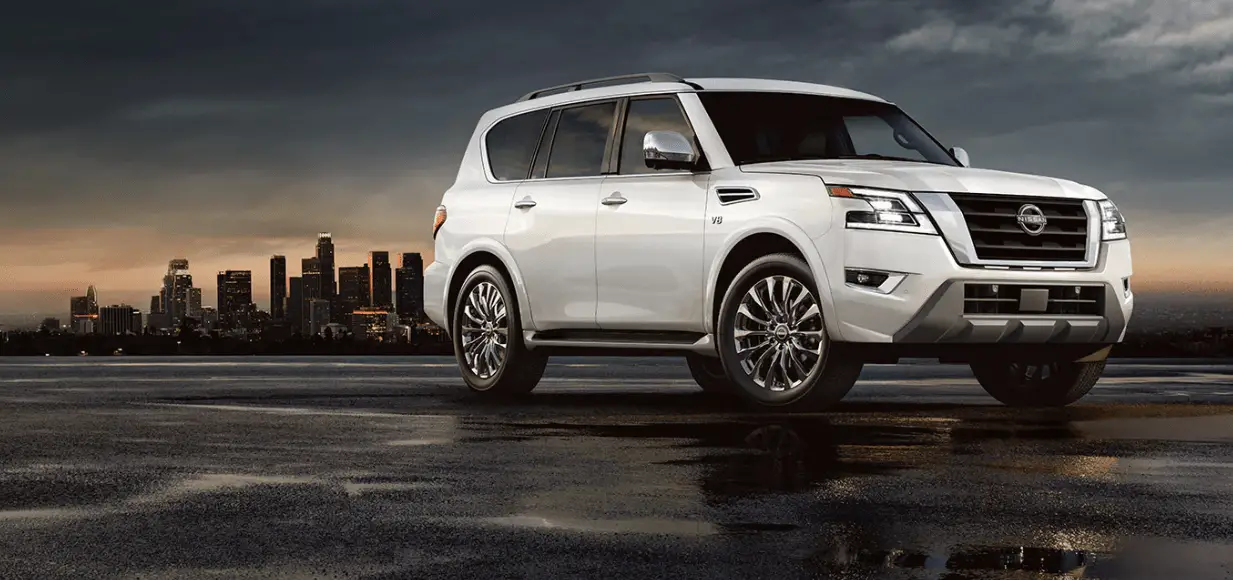Nissan ARMADA 2022 Child Safety and Restraints
The 2022 Nissan Armada places a high priority on kid safety and restraints, offering a wide array of features that are intended to safeguard small passengers. The Armada provides a secure environment for kids of different ages with features including side-impact airbags for extra safety, rear door child locks to prevent unintentional door opening, and LATCH anchors for safe child seat installation. Families can travel with confidence and peace of mind knowing their children are well-protected in the spacious and opulent Armada SUV, thanks to guidelines and recommendations for proper child seat placement and usage. These recommendations include rear-facing seats for infants, forward-facing seats for toddlers, and booster seats for older children.
2023 Nissan Armada Specs, Price, Features and Mileage (Brochure)
Child safety

WARNING
Do not allow children to play with the seat belts. Most seating positions are equipped with Automatic Locking Retractor (ALR) mode seat belts. If the seat belt becomes wrapped around a child’s neck with the ALR mode activated, the child can be seriously injured or killed if the seat belt retracts and becomes tight. This can occur even if the vehicle is parked. Unbuckle the seat belt to release the child. For the center of the 3rd-row bench seat, the connector tongue may also be released. Release the connector tongue by inserting a suitable tool (such as a key) into the connector buckle.If the seat belt cannot be unbuckled or is already unbuckled, release the child by cutting the seat belt with a suitable tool (such as a knife or scissors) to release the seat belt. Children need adults to help protect them. They need to be properly restrained. In addition to the general information in this manual, child safety information is available from many other sources, including doctors, teachers, government traffic safety offices, and community organizations. Every child is different, so be sure to learn the best way to transport your child.
There are three basic types of child restraint systems:
- Rear-facing child restraint
- Forward-facing child restraint
- Booster seat
The proper restraint depends on the child’s size. Generally, infants up to about 1 year and less than 20 lbs (9 kg) should be placed in rear-facing child restraints. Forward-facing child restraints are available for children who outgrow rear-facing child restraints and are at least 1 year old. Booster seats are used to help position a vehicle lap/shoulder belt on a child who can no longer use a forward-facing child restraint.
WARNING
Infants and children need special protection. The vehicle’s seat belts may not fit properly. The shoulder belt may come too close to the face or neck. The lap belt may not fit over their small hip bones. In an accident, an improperly fitting seat belt could cause serious or fatal injury. Always use appropriate child restraints. A child restraint may be secured in the vehicle by using either the LATCH (Lower Anchor and Tethers for CHildren) system or with the vehicle seat belt. NISSAN recommends that all pre-teens and children be restrained in the rear seat. Studies show that children are safer when properly restrained in the rear seat than in the front seat. This is especially important because your vehicle has a supplemental restraint system (Air bag system) for the front passenger.
INFANTS
Infants up to at least 1 year old should be placed in a rear-facing child restraint. NISSAN recommends that infants be placed in child restraints that comply with Federal Motor Vehicle Safety Standards or Canadian Motor Vehicle Safety Standards. You should choose a child restraint that fits your vehicle and always follow the manufacturer’s instructions for installation and use.
SMALL CHILDREN
Children who are over 1 year old and weigh at least 20 lbs (9 kg) should remain in a rear-facing child restraint as long as possible up to the height or weight limit of the child restraint. Children who outgrow the height or weight limit of the rear-facing child restraint and are at least 1 year old should be secured in a forward-facing child restraint with a harness. Refer to the manufacturer’s instructions for minimum and maximum weight and height recommendations. NISSAN recommends that small children be placed in child restraints that comply with Federal Motor Vehicle Safety Standards or Canadian Motor Vehicle Safety Standards. You should choose a child restraint that fits your vehicle and always follow the manufacturer’s instructions for installation and use.
LARGER CHILDREN
Children should remain in a forward-facing child restraint with a harness until they reach the maximum height or weight limit allowed by the child restraint manufacturer. Once a child outgrows the height or weight limit of the harness-equipped forward-facing child restraint, NISSAN recommends that the child be placed in a commercially available booster seat to obtain proper seat belt fit. For a seat belt to fit properly, the booster seat should raise the child so that the shoulder belt is properly positioned across the chest and the top, and middle portions of the shoulder. The shoulder belt should not cross the neck or face and should not fall off the shoulder. The lap belt should lie snugly across the lower hips or upper thighs, not the abdomen. A booster seat can only be used in seating positions that have a three-point type seat belt. The booster seat should fit the vehicle seat and have a label certifying that it complies with Federal Motor Vehicle Safety Standards or Canadian Motor Vehicle Safety Standards.
A booster seat should be used until the child can pass the seat belt fit test below:
- Are the child’s back and hips against the vehicle seatback?
- Is the child able to sit without slouching?
- Do the child’s knees bend easily over the front edge of the seat with feet flat on the floor?
- Can the child safely wear the seat belt (lap belt low and snug across the hips and shoulder belt across midchats and shoulder)?
- Is the child able to use the properly adjusted head restraint/headrest?
- Will the child be able to stay in position for the entire ride?
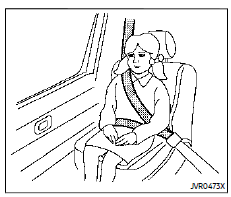
If you answered no to any of these questions, the child should remain in a booster seat using a three-point type seat belt.
NOTE:
Laws in some communities may follow different guidelines. Check local and state regulations to confirm your child is using the correct restraint system before traveling.
WARNING
Never let a child stand or kneel on any seat and do not allow a child in the cargo area. The child could be seriously injured or killed in a sudden stop or collision.
CHILD RESTRAINTS
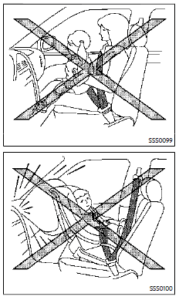
PRECAUTIONS ON CHILD RESTRAINTS
- Failure to follow the warnings and instructions for proper use and installation of child restraints could result in serious injury or death of a child or other passengers in a sudden stop or collision:
- The child restraint must be used and installed properly. Always follow all of the child restraint manufacturer’s instructions for installation and use.
- Infants and children should never be held on anyone’s lap. Even the strongest adult cannot resist the forces of a collision.
- Do not put a seat belt around both a child and another passenger.
- NISSAN recommends that all child restraints be installed in the rear seat.
- Even with the NISSAN Advanced Air Bag System, never install a rear-facing child restraint in the front seat. An inflating air bag could seriously injure or kill a child. A rear-facing child restraint must only be used in the rear seat.
- Be sure to purchase a child restraint that will fit the child and vehicle. Some child restraints may not fit properly in your vehicle.
- Child restraint anchor points are designed to withstand loads from child restraints that are properly fitted.
- Never use the anchor points for adult seat belts or harnesses.
- A child restraint with a top tether strap should not be used in the front passenger seat.
- Keep seatbacks as upright as possible after fitting the child restraint.
- Infants and children should always be placed in an appropriate child restraint while in the vehicle.
- When the child restraint is not in use, keep it secured with the LATCH system or a seat belt. In a sudden stop or collision, loose objects can injure occupants or damage the vehicle.
CAUTION
A child restraint in a closed vehicle can become very hot. Check the seating surface and buckles before placing a child in the child restraint. This vehicle is equipped with a universal child restraint anchor system, referred to as the LATCH (Lower Anchors and Tethers for CHildren) system. Some child restraints include rigid or webbing-mounted attachments that can be connected to these anchors. If you do not have a LATCH-compatible child restraint, the vehicle seat belts can be used. Several manufacturers offer child restraints for infants and small children of various sizes. When selecting any child restraint, keep the following points in mind:
- Choose only a restraint with a label certifying that it complies with Federal Motor Vehicle Safety Standard 213 or Canadian Motor Vehicle Safety Standard 213.
- Check the child restraint in your vehicle to be sure it is compatible with the vehicle’s seat and seat belt system.
- If the child restraint is compatible with your vehicle, place your child in the child restraint and check the various adjustments to be sure the child restraint is compatible with your child. Choose a child restraint that is designed for your child’s height and weight. Always follow all recommended procedures.
- If the combined weight of the child and child restraint is less than 65 lbs (29.5 kg), you may use either the 1-34 Safety — seats, seat belts, and supplemental restraint system LATCH lower anchors or the seat belt to install the child restraint (not both at the same time).
- If the combined weight of the child and child restraint is greater than 65 lbs (29.5 kg), use the vehicle’s seat belt (not the lower anchors) to install the child restraint.
- Be sure to follow the child restraint manufacturer’s instructions for installation.
All U.S. states and Canadian provinces or territories require that infants and small children be restrained in an approved child restraint at all times while the vehicle is being operated. Canadian law requires the top tether strap on forward-facing child restraints to be secured to the designated anchor point on the vehicle.
LATCH system lower anchor locations – captain’s seats
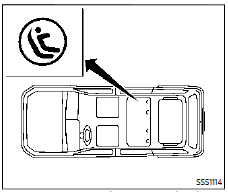
LATCH system lower anchor locations – bench seat
Lower Anchors and Tethers for CHildren (LATCH) SYSTEM
Your vehicle is equipped with special anchor points that are used with the LATCH (Lower Anchors and Tethers for CHildren) system-compatible child restraints. This system may also be referred to as the ISOFIX or ISOFIX-compatible system. With this system, you do not have to use a vehicle seat belt to secure the child restraint unless the combined weight of the child and child restraint exceeds 65 lbs (29.5 kg). If the combined weight of the child and child restraint is greater than 65 lbs (29.5 kg), use the vehicle’s seat belt (not the lower anchors) to install the child restraint. Be sure to follow the child restraint manufacturer’s instructions for installation.
The LATCH lower anchor points are provided to install child restraints in the following positions only:
- 2nd-row captain’s seats (if so equipped)
- 2nd-row bench seat outboard positions only (if so equipped)
LATCH lower anchor
WARNING
Failure to follow the warnings and instructions for proper use and installation of child restraints could result in serious injury or death of a child or other passengers in a sudden stop or collision:
- Attach LATCH system-compatible child restraints only at the locations shown in the illustration.
- Do not secure a child restraint in the center rear seating position using the LATCH lower anchors. The child restraint will not be secured properly.
- Inspect the lower anchors by inserting your fingers into the lower anchor area. Feel to make sure there are no obstructions over the anchors such as seat belt webbing or seat cushion material. The child restraint will not be secured properly if the lower anchors are obstructed.
- Child restraint anchorages are designed to withstand only those loads imposed by correctly fitted child restraints. Under no circumstances are they to be used to attach adult seat belts, or other items or equipment to the vehicle. Doing so could damage the child restraint anchorages. The child restraint will not be properly installed using the damaged anchorage, and a child could be seriously injured or killed in a collision.
LATCH lower anchor location
The LATCH lower anchor points are provided to install child restraints in the rear outboard seating positions only. Do not attempt to install a child restraint in the center seating position using the LATCH lower anchors.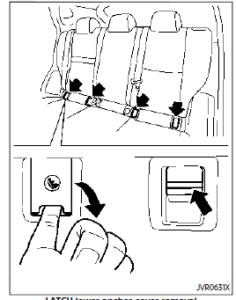
LATCH lower anchor cover removal
The LATCH lower anchor points are located under the covers labeled ISOFIX at the bottom of the rear outboard seat cushions. To access a LATCH lower anchor point, insert your finger into the cover and pull the cover off.
CAUTION
Store the loose LATCH covers (for example, in the console box) where they will not get damaged to avoid losing them.

LATCH webbing-mounted attachment
Installing child restraint LATCH lower anchor attachments
LATCH-compatible child restraints include two rigid or webbing-mounted attachments that can be connected to two anchors located at certain seating positions in your vehicle. With this system, you do not have to use a vehicle seat belt to secure the child restraint. Check your child’s restraint for a label stating that it is compatible with LATCH. This information may also be in the instructions provided by the child restraint manufacturer.

LATCH rigid-mounted attachment
When installing a child restraint, carefully read and follow the instructions in this manual and those supplied with the child restraint.


3rd row bench seat
TOP TETHER STRAP CHILD RESTRAINT
If the manufacturer of your child restraint requires the use of a top tether strap, it must be secured to an anchor point.
WARNING
- In the 3rd-row bench seat, a child restraint with a top tether strap can only be used in the outboard seating position (right side). Do not place it in the outboard seating position (left side) and center position and attempt to angle the tether strap to the outboard seating position (right side).
- Child restraint anchorages are designed to withstand only those loads imposed by correctly fitted child restraints. Under no circumstances are they to be used to attach adult seat belts, or other items or equipment to the vehicle. Doing so could damage the child restraint anchorages. The child restraint will not be properly installed using the damaged anchorage, and a child could be seriously injured or killed in a collision.
- Properly secure cargo and do not allow it to contact the top tether strap when it is attached to the top tether anchor. Cargo that is not properly secured or cargo that contacts the top tether strap may damage the top tether strap during a collision. Your child could be seriously injured or killed in a collision if the child restraint top tether strap is damaged.
Top tether anchor point locations
Anchor points are located in the following locations:
- 2nd-row bench seat (if so equipped) on the seatback of the outboard seating positions as shown.
- 2nd-row captain’s seats (if so equipped) on the seatback of the outboard seating positions as shown.
- A 3rd-row bench seat on the seatback of the outboard seating position (right side) as shown.
If you have any questions when installing a top tether strap child restraint on the rear seat, it is recommended you visit a NISSAN dealer for this service.
REAR-FACING CHILD RESTRAINT INSTALLATION USING A LATCH
Refer to all Warnings and Cautions in the “Child safety” and “Child restraints” sections before installing a child restraint. Do not use the lower anchors if the combined weight of the child and the child restraint exceeds 65 lbs (29.5 kg). If the combined weight of the child and the child restraint is greater than 65 lbs (29.5 kg), use the vehicle’s seat belt (not the lower anchors) to install the child restraint. Be sure to follow the child restraint manufacturer’s instructions for installation.
Follow these steps to install a rear-facing child restraint in the 2nd-row seats using the LATCH system:
- Position the child restraint on the seat.
Always follow the child restraint manufacturer’s instructions.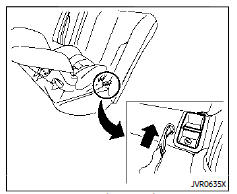
Rear-facing web-mounted — step 2 - Secure the child restraint anchor attachments to the LATCH lower anchors. Check to make sure the LATCH attachment is properly attached to the lower anchors.
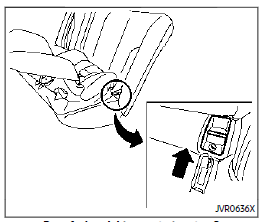
Rear-facing rigid-mounted — step 2
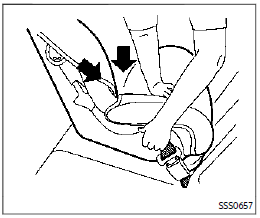
Rear-facing — step 3 - For child restraints that are equipped with webbing-mounted attachments, remove any additional slack from the anchor attachments. Press downward and rearward firmly in the center of the child restraint with your hand to compress the vehicle seat cushion and seatback while tightening the webbing of the anchor attachments.
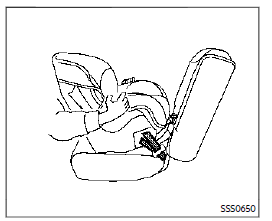 Rear-facing — step 4
Rear-facing — step 4 - After attaching the child restraint, test it before you place the child in it. Push it from side to side while holding the child restraint near the LATCH attachment path. The child restraint should not move more than 1 inch (25 mm), from side to side. Try to tug it forward and check to see if the LATCH attachment holds the restraint in place. If the restraint is not secure, tighten the LATCH attachment as necessary, or put the restraint in another seat and test it again. You may need to try a different child restraint or try installing by using the vehicle seat belt (if applicable). Not all child restraints fit in all types of vehicles.
- Check to make sure the child restraint is properly secured prior to each use. If the child restraint is loose, repeat steps 1 through 4.
REAR-FACING CHILD RESTRAINT INSTALLATION USING THE SEAT BELTS
WARNING
- The three-point seat belt with Automatic Locking Retractor (ALR) must be used when installing a child restraint. Failure to use the ALR mode will result in the child restraint not being properly secured. The restraint could tip over or be loose and cause injury to a child in a sudden stop or collision. Also, it can change the operation of the front passenger air bag. When installing a child restraint system in the 3rd center seat position, both the center seat belt connector tongue and buckle tongue must be secured.
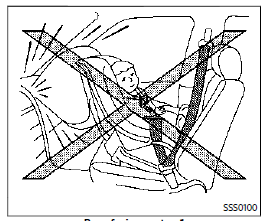
Rear-facing — step 1
Do not use the lower anchors if the combined weight of the child and the child restraint exceeds 65 lbs (29.5 kg). If the combined weight of the child and the child restraint is greater than 65 lbs (29.5 kg), use the vehicle’s seat belt (not the lower anchors) to install the child restraint. Be sure to follow the child restraint manufacturer’s instructions for installation.
Follow these steps to install a rear-facing child restraint using the vehicle seat belts in the rear seats:
- Child restraints for infants must be used in the rear-facing direction and therefore must not be used in the front seat. Position the child restraint on the seat. Always follow the restraint manufacturer’s instructions.
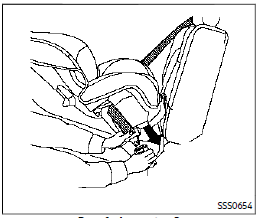
Rear-facing — step 2 - Route the seat belt tongue through the child restraint and insert it into the buckle until you hear and feel the latch engage. Be sure to follow the child restraint manufacturer’s instructions for belt routing.
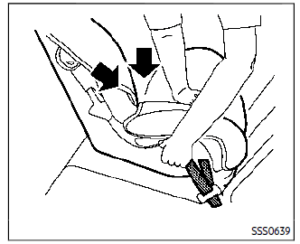 Rear-facing — step 3
Rear-facing — step 3 - Pull the shoulder belt until the belt is fully extended. At this time, the seat belt retractor is in the Automatic Locking Retractor (ALR) mode (child restraint mode). It reverts to the Emergency Locking Retractor (ELR) mode when the seat belt is fully retracted.

Rear-facing — step 4 - Allow the seat belt to retract. Pull up on the shoulder belt to remove any slack in the belt.
Rear-facing — step 5 - Remove any additional slack from the seat belt; press downward and rearward firmly in the center of the child restraint to compress the vehicle seat cushion and seatback while pulling up on the seat belt.
Rear-facing — step 6 - After attaching the child restraint, test it before you place the child in it. Push it from side to side while holding the child restraint near the seat belt path. The child restraint should not move more than 1 inch (25 mm), from side to side. Try to tug it forward and check to see if the belt holds the restraint in place. If the restraint is not secure, tighten the seat belt as necessary, or put the restraint in another seat and test it again. You may need to try a different child restraint. Not all child restraints fit in all types of vehicles.
- Check to make sure that the child restraint is properly secured prior to each use. If the seat belt is not locked, repeat steps 1 through 6.
After the child restraint is removed and the seat belt fully retracted, the ALR mode (child restraint mode) is canceled.
FORWARD-FACING CHILD RESTRAINT INSTALLATION USING A LATCH
Refer to all Warnings and Cautions in the “Child safety” and “Child restraints” sections before installing a child restraint. Do not use the lower anchors if the combined weight of the child and the child restraint exceeds 65 lbs (29.5 kg). If the combined weight of the child and the child restraint is greater than 65 lbs (29.5 kg), use the vehicle’s seat belt (not the lower anchors) to install the child restraint. Be sure to follow the child restraint manufacturer’s instructions for installation.
Follow these steps to install a forward-facing child restraint using the LATCH system:
- Position the child restraint on the seat
- Always follow the child restraint manufacturer’s instructions.
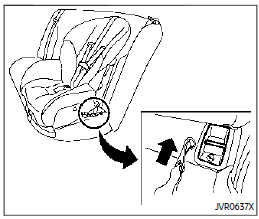
Forward-facing web-mounted — step 2 - Secure the child restraint anchor attachments to the LATCH lower anchors. Check to make sure the LATCH attachment is properly attached to the lower anchors. If the child restraint is equipped with a top tether strap, route the top tether strap and secure the tether strap to the tether anchor point. Do not install child restraints that require the use of a top tether strap in seating positions that do not have a top tether anchor.

- Forward facing rigid-mounted — step 2
- The back of the child restraint should be secured against the vehicle seat-back.
- If necessary, adjust or remove the head restraint to obtain the correct child restraint fit. If the head restraint is removed, store it in a secure place.
- If the seating position does not have an adjustable headrest or a headrest and it is interfering with the proper child restraint fit, try another seating position or a different child restraint.
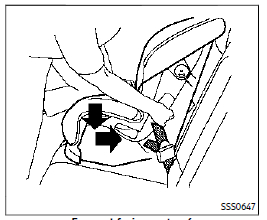 Forward-facing — step 4
Forward-facing — step 4 - For child restraints that are equipped with webbing-mounted attachments, remove any additional slack from the anchor attachments. Press downward and rearward firmly in the center of the child restraint with your knee to compress the vehicle seat cushion and seatback while tightening the webbing of the anchor attachments.
- Tighten the tether strap according to the manufacturer’s instructions to remove any slack.
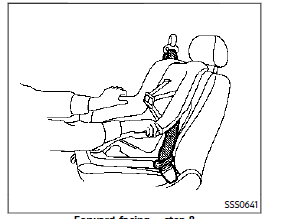
Forward-facing — step 6 - After attaching the child restraint, test it before you place the child in it. Push it from side to side while holding the child restraint near the LATCH attachment path. The child restraint should not move more than 1 inch (25 mm), from side to side. Try to tug it forward and check to see if the LATCH attachment holds the restraint in place. If the restraint is not secure, tighten the LATCH attachment as necessary, or put the restraint in another seat and test it again. You may need to try a different child restraint. Not all child restraints fit in all types of vehicles.
- Check to make sure the child restraint is properly secured prior to each use. If the child restraint is loose, repeat steps 1 through 6.
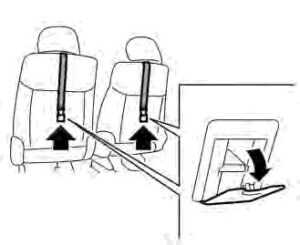
2nd row captain’s seat
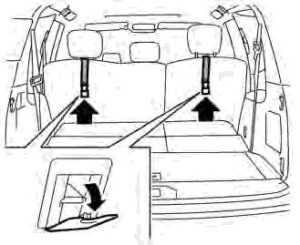
2nd row bench seat
Installing top tether strap
First, secure the child restraint with the LATCH lower anchors (2nd-row captain’s or bench outboard seating positions only).
- If necessary, raise or remove the head restraint or headrest to position the top tether strap over the top of the seatback. If the head restraint or headrest is removed, store it in a secure place.
- Secure the tether strap to the tether anchor point on the back of each seatback behind the child restraint.
- Tighten the tether strap according to the manufacturer’s instructions to remove any slack. Make sure the head restraint or headrest does not contact the top tether strap.
If you have any questions when installing a top tether strap on the rear seat, it is recommended you visit a NISSAN dealer for this service.
FORWARD-FACING CHILD RESTRAINT INSTALLATION USING THE SEAT BELTS
WARNING
- The three-point seat belt with Automatic Locking Retractor (ALR) must be used when installing a child restraint. Failure to use the ALR mode will result in the child restraint not being properly secured. The restraint could tip over or be loose and cause injury to a child in a sudden stop or collision. Also, it can change the operation of the front passenger airbag. When installing a child restraint system in the 3rd center position, both the center seat belt connector tongue and buckle tongue must be secured.

Forward-facing (front passenger seat) — step 1
Refer to all Warnings and Cautions in the “Child safety” and “Child restraints” sections before installing a child restraint.
Do not use the lower anchors if the combined weight of the child and the child restraint exceeds 65 lbs (29.5 kg). If the combined weight of the child and the child restraint is greater than 65 lbs (29.5 kg), use the vehicle’s seat belt (not the lower anchors) to install the child restraint. Be sure to follow the child restraint manufacturer’s instructions for installation.
Follow these steps to install a forward-facing child restraint using the vehicle seat belt in the rear seats or in the front passenger seat:
- If you must install a child restraint in the front seat, it should be placed in a forward-facing direction only. Move the seat to the rear position. Child restraints for infants must be used in the rear-facing direction and, therefore, must not be used in the front seat.
- Position the child restraint on the seat. Always follow the child restraint manufacturer’s instructions.
The back of the child restraint should be secured against the vehicle seat-back.
If the seating position does not have an adjustable headrest or a headrest and it is interfering with the proper child restraint fit, try another seating position or a different child.
Forward-facing — step 3 - Route the seat belt tongue through the child restraint and insert it into the buckle until you hear and feel the latch engage. Be sure to follow the child restraint manufacturer’s instructions for belt routing.
If the child restraint is equipped with a top tether strap, route the top tether strap and secure the tether strap to the tether anchor point (rear seat installation only).
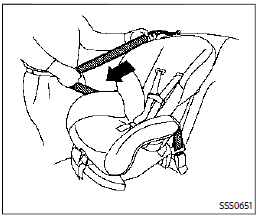 Forward-facing — step 4
Forward-facing — step 4 - Pull the shoulder belt until the belt is fully extended. At this time, the seat belt retractor is in the Automatic Locking Retractor (ALR) mode (child restraint mode). It reverts to Emergency Locking Retractor (ELR) mode when the seat belt is fully retracted.
 Forward-facing — step 5
Forward-facing — step 5 - Allow the seat belt to retract. Pull up on the shoulder belt to remove any slack in the belt.
 Forward-facing — step 6
Forward-facing — step 6 - Remove any additional slack from the seat belt; press downward and rearward firmly in the center of the child restraint with your knee to compress the vehicle seat cushion and seatback while pulling up on the seat belt.
- Tighten the tether strap according to the manufacturer’s instructions to remove any slack.
 Forward-facing — step 8
Forward-facing — step 8 - After attaching the child restraint, test it before you place the child in it. Push it from side to side while holding the child restraint near the seat belt path. The child restraint should not move more than 1 inch (25 mm), from side to side. Try to tug it forward and check to see if the belt holds the restraint in place. If the restraint is not secure, tighten the seat belt as necessary, or put the restraint in another seat and test it again. You may need to try a different child restraint. Not all child restraints fit in all types of vehicles.
- Check to make sure the child restraint is properly secured prior to each use. If the seat belt is not locked, repeat steps 2 through 8.
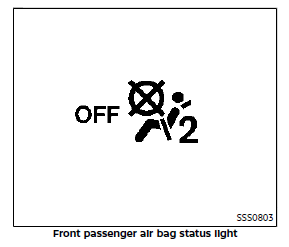
After the child restraint is removed and the seat belt is fully retracted, the ALR mode (child restraint mode) is canceled.
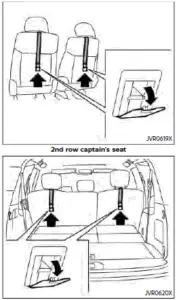
2nd row bench seat

3rd-row bench seat
Installing top tether strap
WARNING
In the 3rd-row bench seat, a child restraint with a top tether strap can only be used in the outboard seating position (right side). Do not place it in the outboard seating position (left side) and center position and attempt to angle the tether strap to the outboard seating position (right side).
First, secure the child’s restraint with the seat belt.
- If necessary, raise or remove the head restraint or headrest to position the top tether strap over the top of the seatback. If the head restraint or headrest is removed, store it in a secure place. Be sure to reinstall the head restraint or headrest when the child restraint is removed.
- Secure the tether strap to the tether anchor point on the back of each seatback (2nd-row seat) or right side seatback (3rd-row seat) behind the child restraint.
- Tighten the tether strap according to the manufacturer’s instructions to remove any slack. Make sure the head restraint or headrest does not contact the top tether strap.
If you have any questions when installing a top tether strap on the rear seat, it is recommended you visit a NISSAN dealer for this service.
BOOSTER seat Precautions on booster seats
If a booster seat and seat belt are not used properly, the risk of a child being injured in a sudden stop or collision greatly increases:
- Make sure the shoulder portion of the belt is away from the child’s face and neck and the lap portion of the belt does not cross the stomach.
- Make sure the shoulder belt is not behind the child or under the child’s arm.
- A booster seat must only be installed in a seating position that has a lap/shoulder belt.
- Booster seats of various sizes are offered by several manufacturers. When selecting any booster seat, keep the following points in mind:
- Choose only a booster seat with a label certifying that it complies with Federal Motor Vehicle Safety Standard 213 or Canadian Motor Vehicle Safety Standard 213.
- Check the booster seat in your vehicle to be sure it is compatible with the vehicle’s seat and seat belt system.
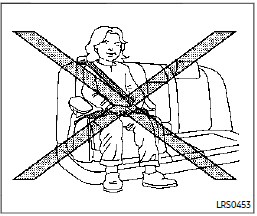
Make sure the child’s head will be properly supported by the booster seat or vehicle seat. The seatback must be at or above the center of the child’s ears. For example, if a low-back booster seat is chosen, the vehicle seatback must be at or above the center of the child’s ears. If the seatback is lower than the center of the child’s ears, a high-back booster seat should be used. If the booster seat is compatible with your vehicle, place your child in the booster seat and check the various adjustments to be sure the booster seat is compatible with your child.
Always follow all recommended pro-
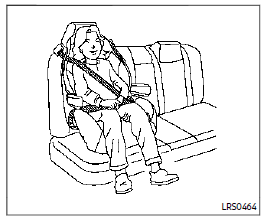
All U.S. states and Canadian provinces or territories require that infants and small children be restrained in an approved child restraint at all times while the vehicle is being operated. The instructions in this section apply to booster seat installation in the rear seats or the front passenger seat.
Booster seat installation
CAUTION
Do not use the lap/shoulder belt Automatic Locking Retractor (ALR) mode when using a booster seat with the seat belts. Refer to all Warnings and Cautions in the “Child safety”, “Child restraints” and “Booster seats” sections earlier in this section before installing a child restraint.
Follow these steps to install a booster seat in the rear seat or in the front passenger seat:
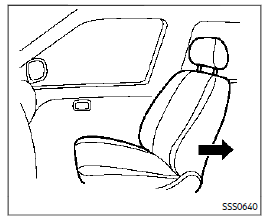
- If you must install a booster seat in the front seat, move the seat to the rear position.
- Position the booster seat on the seat. Only place it in a forward-facing direction. Always follow the booster seat manufacturer’s instructions.
 Front passenger position
Front passenger position - The booster seat should be positioned on the vehicle seat so that it is stable.
If the seating position does not have an adjustable headrest or a headrest and it is interfering with the proper booster seat fit, try another seating position or a different booster seat. - Position the lap portion of the seat belt low and snug on the child’s hips. Be sure to follow the booster seat manufacturer’s instructions for adjusting the seat belt routing.
- Pull the shoulder belt portion of the seat belt toward the retractor to take up the extra slack. Be sure the shoulder belt is positioned across the top, the middle portion of the child’s shoulder. Be sure to follow the booster seat manufacturer’s instructions for adjusting the seat belt routing.
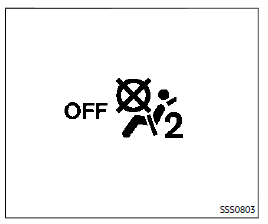
- If the booster seat is installed in the front passenger seat, place the ignition switch in the ON position. The front passenger air bag status light may or may not illuminate depending on the size of the child and the type of booster seat used.=
FAQ
What kind of child safety features are included in the Nissan ARMADA 2022?
The Nissan ARMADA 2022 comes equipped with a range of advanced safety features for child passengers, including child safety and child restraint systems, rear door child safety locks, and a child safety rear seat belt.
Does the Nissan ARMADA 2022 have LATCH anchors?
Yes, the Nissan ARMADA 2022 has Lower Anchors and Tethers for CHildren (LATCH) anchors, which are standard in all second-row seating positions and in the third-row passenger-side seating position.
What are the weight and height limits for child seats in the Nissan ARMADA 2022?
The weight and height limits for child seats in the Nissan ARMADA 2022 vary depending on the type of child seat being used. It is important to refer to the specific manufacturer’s instructions for weight and height limits.
How many child seats can be installed in the Nissan ARMADA 2022?
The number of child seats that can be installed in the Nissan ARMADA 2022 depends on the size and type of the seats being used. It is recommended to refer to the vehicle’s owner’s manual and the child seat manufacturer’s instructions for guidance on proper installation.
What are the types of child restraints available for the Nissan ARMADA 2022?
The types of child restraints available for the Nissan ARMADA 2022 include rear-facing, forward-facing, and booster seats.
How do I know which child restraint system to use for my child?
The choice of a child restraint system depends on the child’s weight, height, and age. It is recommended to consult the vehicle owner’s manual and the child seat manufacturer’s instructions for guidance on selecting and installing the appropriate child restraint system.
Can I install a forward-facing child restraint in the front seat of the Nissan ARMADA 2022?
It is not recommended to install a forward-facing child restraint in the front seat of the Nissan ARMADA 2022, as it may not be safe due to the presence of airbags.
Can I turn off the front passenger airbag to install a rear-facing child restraint in the front seat of the Nissan ARMADA 2022?
Yes, the front passenger airbag can be turned off to install a rear-facing child restraint in the front seat of the Nissan ARMADA 2022. However, it is recommended to refer to the vehicle’s owner’s manual and the child seat manufacturer’s instructions for proper installation.
How do I properly install a child restraint in the Nissan ARMADA 2022?
It is recommended to refer to the vehicle’s owner manual and the child seat manufacturer’s instructions for the proper installation of a child restraint in the Nissan ARMADA 2022.
Can I use a seatbelt to install a child restraint in the Nissan ARMADA 2022?
Yes, a seatbelt can be used to install a child restraint in the Nissan ARMADA 2022. It is recommended to follow the vehicle owner’s manual and the child seat manufacturer’s instructions for proper installation.
Can I use a booster seat in the Nissan ARMADA 2022?
Yes, a booster seat can be used in the Nissan ARMADA 2022. It is recommended to follow the vehicle owner’s manual and the child seat manufacturer’s instructions for proper installation.
How do I check if the child restraint is installed properly in the Nissan ARMADA 2022?
It is recommended to refer to the vehicle’s owner manual and the child seat manufacturer’s instructions for guidance on how to check if the child restraint is properly installed in the Nissan ARMADA 2022.
What should I do if my child outgrows the weight or height limit of their current restraint in the Nissan ARMADA 2022?
If a child outgrows the weight or height limit of their current restraint in the Nissan ARMADA 2022, they should be moved to the next appropriate restraint based on their age, weight, and height. It is important to always follow the manufacturer’s instructions for each type of child restraint and make sure it is properly installed in the vehicle.
Does the Nissan ARMADA 2022 have a rear-seat reminder system?
Yes, the Nissan ARMADA 2022 has a rear-seat reminder system that alerts the driver to check the rear seat before exiting the vehicle to ensure no child is left behind. This feature is designed to help prevent children from being accidentally left in the vehicle, which can lead to heatstroke or other serious harm.
What should I do if the airbag warning light illuminates when I have a child restraint installed in the Nissan ARMADA 2022?
If the airbag warning light illuminates when a child restraint is installed in the Nissan ARMADA 2022, it may indicate that the front passenger airbag has been turned off to accommodate a rear-facing child restraint. However, if the light remains on, it could indicate a problem with the airbag system. In this case, the vehicle should be taken to a Nissan dealer or authorized repair facility for inspection and repair.
Useful Links
View Full User Guide: Nissan ARMADA 2022 User Guide
Download Manuals: https://www.nissanusa.com/owners/ownership/manuals-guides.html
2023 Nissan Armada Specs, Price, Features and Mileage (Brochure)

